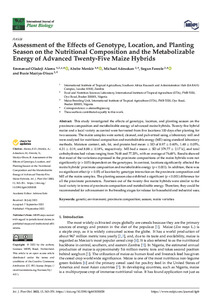| dc.contributor.author | Alamu, E.O. |
| dc.contributor.author | Menkir, A. |
| dc.contributor.author | Adesokan, M. |
| dc.contributor.author | Fawole, S. |
| dc.contributor.author | Maziya-Dixon, B. |
| dc.date.accessioned | 2022-09-23T08:59:28Z |
| dc.date.available | 2022-09-23T08:59:28Z |
| dc.date.issued | 2022-09-09 |
| dc.identifier.citation | Alamu, E.O., Menkir, A., Adesokan, M., Fawole, S. & Maziya-Dixon, B. (2022). Assessment of the effects of genotype, location, and planting season on the nutritional composition and the metabolizable energy of advanced twenty-five maize hybrids. International Journal of Plant Biology, 13(3), 343-351. |
| dc.identifier.issn | 2037-0164 |
| dc.identifier.uri | https://hdl.handle.net/20.500.12478/7801 |
| dc.description.abstract | This study investigated the effects of genotype, location, and planting season on the proximate composition and metabolizable energy of advanced maize hybrids. Twenty-five hybrid maize and a local variety as control were harvested from five locations 100 days after planting for two seasons. The maize samples were sorted, cleaned, and pulverized using a laboratory mill and were analyzed for nutritional composition and metabolizable energy (ME) using standard laboratory methods. Moisture content, ash, fat, and protein had mean ± SD of 8.97 ± 0.40%, 1.48 ± 0.05%, 4.31 ± 0.19, and 8.88 ± 0.18%, respectively. ME had a mean ± SD of 379.77 ± 2.17 kJ, and total carbohydrates had values ranging from 74.68 and 77.20%, with an average of 76.68%. Results showed that most of the variations expressed in the proximate compositions of the maize hybrids were not significantly (p > 0.05) dependent on the genotypes. In contrast, locations significantly affected the maize hybrids’ proximate composition and metabolizable energy (p < 0.001). In addition, there was no significant effect (p > 0.05) of location by genotype interaction on the proximate composition and ME of the maize samples. The planting season also exhibited a significant (p < 0.001) difference for all the proximate parameters. Fourteen out of the twenty-five maize hybrids were similar to the local variety in terms of proximate composition and metabolizable energy. Therefore, they could be recommended for advancement in the breeding stages for release for household and industrial uses. |
| dc.description.sponsorship | International Institute of Tropical Agriculture |
| dc.description.sponsorship | Bill & Melinda Gates Foundation |
| dc.format.extent | 343-351 |
| dc.language.iso | en |
| dc.subject | Genetics |
| dc.subject | Environment |
| dc.subject | Proximate Composition |
| dc.subject | Maize |
| dc.subject | Varieties |
| dc.subject | Hybrids |
| dc.subject | Planting |
| dc.subject | Seasons |
| dc.title | Assessment of the effects of genotype, location, and planting season on the nutritional composition and the metabolizable energy of advanced twenty-five maize hybrids |
| dc.type | Journal Article |
| cg.contributor.crp | Agriculture for Nutrition and Health |
| cg.contributor.crp | Maize |
| cg.contributor.affiliation | International Institute of Tropical Agriculture |
| cg.coverage.region | Africa |
| cg.coverage.region | West Africa |
| cg.coverage.country | Nigeria |
| cg.coverage.hub | Headquarters and Western Africa Hub |
| cg.researchtheme | Biotech and Plant Breeding |
| cg.researchtheme | Nutrition and Human Health |
| cg.identifier.bibtexciteid | ALAMU:2022d |
| cg.isijournal | ISI Journal |
| cg.authorship.types | CGIAR Single Centre |
| cg.iitasubject | Aflatoxin |
| cg.iitasubject | Agronomy |
| cg.iitasubject | Crop Systems |
| cg.iitasubject | Food Systems |
| cg.iitasubject | Maize |
| cg.iitasubject | Nutrition |
| cg.iitasubject | Plant Breeding |
| cg.journal | International Journal of Plant Biology |
| cg.notes | Open Access Article |
| cg.accessibilitystatus | Open Access |
| cg.reviewstatus | Peer Review |
| cg.usagerightslicense | Creative Commons Attribution 4.0 (CC BY 0.0) |
| cg.targetaudience | Scientists |
| cg.identifier.doi | https://dx.doi.org/10.3390/ijpb13030028 |
| cg.iitaauthor.identifier | Alamu Emmanuel Oladeji: 0000-0001-6263-1359 |
| cg.iitaauthor.identifier | Abebe Menkir: 0000-0002-5907-9177 |
| cg.futureupdate.required | No |
| cg.identifier.issue | 3 |
| cg.identifier.volume | 13 |

